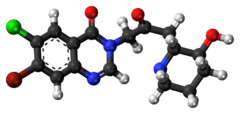Halofuginone
 | |
 | |
| Clinical data | |
|---|---|
| AHFS/Drugs.com | International Drug Names |
| ATCvet code | QP51AX08 (WHO) |
| Identifiers | |
| |
| CAS Number |
55837-20-2 |
| PubChem (CID) | 400772 |
| ChemSpider |
355164 |
| UNII |
L31MM1385E |
| ChEMBL |
CHEMBL1199540 |
| Chemical and physical data | |
| Formula | C16H17BrClN3O3 |
| Molar mass | 414.68 g/mol |
| 3D model (Jmol) | Interactive image |
| |
| |
| | |
Halofuginone is a coccidiostat used in veterinary medicine. It is a synthetic halogenated derivative of febrifugine, a natural quinazolinone alkaloid which can be found in the Chinese herb Dichroa febrifuga (Chang Shan).[1] Collgard Biopharmaceuticals is developing halofuginone for the treatment of scleroderma and it has received orphan drug designation from the U.S. Food and Drug Administration.[2]
Halofuginone inhibits the development of T helper 17 cells, immune cells that play an important role in autoimmune disease, but it does not affect other kinds of T cells which are involved in normal immune function.[3] Halofuginone therefore has potential for the treatment of autoimmune disorders.[4]
Halofuginone is also an inhibitor of collagen type I gene expression and as a consequence it may inhibit tumor cell growth.[1] Halofuginone exerts its effects by acting as a high affinity inhibitor of the enzyme Glutamyl-Prolyl tRNA synthetase. Inhibition of prolyl tRNA charging leads to the accumulation of uncharged prolyl tRNAs, which serve as a signal to initiate the amino acid starvation response, which in turn exerts anti-inflammatory and anti-fibrotic effects.[5]
References
- 1 2 Halofuginone hydrobromide, NCI Drug Dictionary
- ↑ Halofuginone Receives FDA Orphan Drug Status For Scleroderma, March 10, 2000
- ↑ Sundrud, M. S.; Koralov, S. B.; Feuerer, M.; Calado, D. P.; Kozhaya, A. E.; Rhule-Smith, A.; Lefebvre, R. E.; Unutmaz, D.; Mazitschek, R. (2009). "Halofuginone Inhibits TH17 Cell Differentiation by Activating the Amino Acid Starvation Response". Science. 324 (5932): 1334–8. doi:10.1126/science.1172638. PMC 2803727
 . PMID 19498172.
. PMID 19498172. - ↑ A new lead for autoimmune disease: A small-molecule drug inhibits Th17 cells, eases symptoms in mouse model, June 4, 2009
- ↑ Keller et al (2012) Halofuginone and other febrifugine derivatives inhibit prolyl-trna synthetase. Nature Chemical Biology 12;8(3):311-7. doi: 10.1038/nchembio.790.